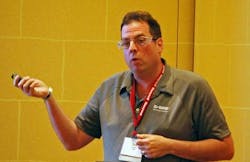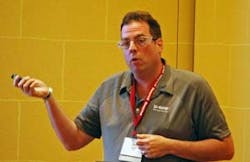“The Timeline view gives us better tracking with less screens and clicks, which allows operators to be more proactive.” BASF’s Dave Vollmer discussed the company’s recent implementation of Honeywell Batch, which features a range of innovative visualization tools tailored specifically to batch operations.
As part of its development process for the new Experion Batch control system, Honeywell gathered input from potential customers and tested the system on real processes in real plants with operators. Some of that testing was performed at BASF polymer-manufacturing facilities.“Our products are reactive mixtures. If you do them right, they’re like a suspension of rubber in water. If something goes wrong, you get a Superball and the agitator seizes up,” said Dave Vollmer, technology manager, BASF, to attendees of his session at Honeywell Users Group Americas 2018 this week in San Antonio.
The BASF facility manufacture polymers in semi-batch operations using many raw materials and parallel steps. They have many unique product variants for recipe structure and needs, as well as class-based recipes across different-sized trains. The operators allocate units dynamically during batch execution, and “active step changing is very common,” said Vollmer. “There is a safety instrumented system (SIS) running in the background.”
BASF offered two sites for tests, with different histories and needs. Site A is a less-complex batch island in a continuous plant. Based on Experion and Sequential Control Module (SCM) programming from the start, it is now on Experion Batch Manager. “They’re working on getting it up to where it can be,” said Vollmer.
Site B is more complex. Originally TDC 3000, it was converted to Experion, running TotalPlant Batch. “It’s stable, proven and closer to where we want it to be, but it’s been a painful process,” Vollmer said. “Its challenges are to find a migration path and timing.”
While their control needs and priorities vary, both sites are looking for improvements in several areas:
- Active step capability
- Operational stability that avoids major lockups
- SFC-consistent view and ability to manipulate an active batch
- Speedy build of new recipes
- Flawless unit arbitration, consistent ownership behavior and nulls
- On-site maintainability and ability to upgrade without special experience
- Failure and “first out” detection
- Quick and intuitive systems for new operators and engineers
- Batch reporting, with quick and easy query at time of disruption
- Simulation system availability and usability
Vollmer emphasized that any new system should be carefully considered. “Some of the decisions you make can lock you in and make it hard to change,” he said. “Take the time at the beginning to get it right.”
Operators weigh in
“The user interface testing on a real process was like Disney World’s ‘Imagineering,’” Vollmer said. Instead of just trying to fix problems, “We were asked, ‘What could be?’”
In May 2018, tests were conducted using actual plant products and databases at both sites, with both engineers and front-line operators. “We were testing features planned for the next release, as well as possible future features,” Vollmer added. “It was a two-way learning opportunity.”
Readers can familiarize themselves with the new Experion Batch operator interface in in a clear, concise video at www.youtube.com/watch?v=JGcJscfdNrs.
“Our existing systems have screens galore, for operations, business and safety systems. It’s a problem during upsets,” Vollmer said. The new system’s Notification Center screen puts critical information in one place—operators can see that there’s a problem, see where in the logic the problem is occurring and often correct it.
“The Timeline screen was new to us,” said Vollmer. “Our existing system has multiple views. You can get a picture in your head, but this gives us better tracking with fewer screens and clicks, which allows operators to be more proactive. Instead of letting the system come to them, it lets them look out ahead and see what’s coming.”
Among the operators, “The timeline view generated considerable conversation,” Vollmer said. “The across-units view let them find problems closer to when they occurred, with a good balance of the current details needed for individual batches.”
The Reference Batch feature compares current operations to a set of stored parameters. “It provides continuous asset effectiveness and improvement tools,” Vollmer said. “In our existing system, we have the data somewhere, but this puts it right in front of us. And when we’re running multiple batches, things can get away from us—a step can stall without tripping an alarm. That can add up to a lot of lost reactor hours and money.”
Users are able to change and refine the reference batch. “If it’s too strict, you get too many notifications, which can annoy the operators. The ability to refine the settings helps,” explained Vollmer.
The Procedure Explorer view is similar to previous systems and helps to “bridge the gap for operations,” Vollmer said. “It allows for quicker engagement and focus on the functionality of interest to experienced operators. They feel like it’s already their system.
“When it comes to new things, usually you have to drag the operators through it. Here, they were clicking away and engaged. We had to drag them away for the next guy to have a turn.”
About the Author
Paul Studebaker
Paul Studebaker

Leaders relevant to this article:


